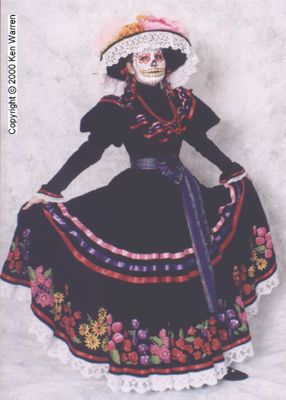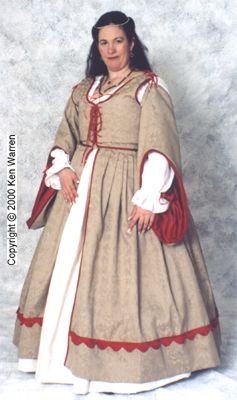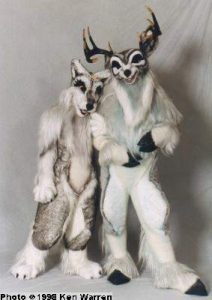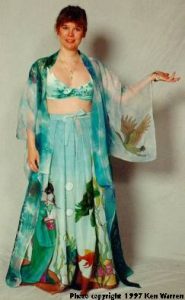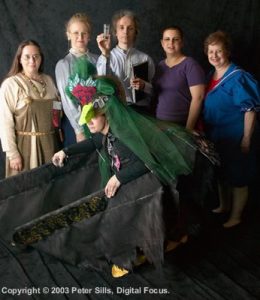CC18-OFFS-H-01: Raeffello Gown
Competition Staff & Rules
Staff:
- Co-Directors: Deborah K. Jones and Carol Salemi
- Master of Ceremonies: Craig Enslin
- Presentation Judges: Darla Kruger, Diane Kovalcin and Pierre E. Pettinger, Jr.
Rules:
The Costume-Con Historical Masquerade recognizes scholarship, creativity, workmanship, and stage presentation skills in the context of historical costume. The spirit of this competition is to celebrate the history of clothing, all periods, any cultures. In the context of Costume-Con, “historical costume” is based on clothing that was worn or could have been worn somewhere in the world in the past – any part of the past. This year, for the first time, the Historical Masquerade will be presented on Saturday evening.
Our judges will give awards on the basis of:
* DOCUMENTATION: Required but minimal. For documentation guidelines, [please see below].
* WORKMANSHIP: You’ll meet individually with the judges on Saturday afternoon to show off your costume up close and point out all your wonderful work.
* PRESENTATION: Complete your illusion of history on stage Saturday evening before an appreciative audience.
SKILL LEVEL DIVISIONS
Master
* Open to anyone who wishes to compete in this division.
* Contestants who have won awards at Costume-Cons for three or more historical costumes must compete in this division.
* Professional costume makers are expected to compete as Masters.
Journeyman
* Open to anyone who is not required to compete in the Master Division.
* If you have previously won an award for a historical costume (but not three or more) you may compete in either Journeyman or Master but not Novice.
* If you compete at the Master level in the Science Fiction and Fantasy Masquerade, you are expected to start at Journeyman in the Historical Masquerade.
Novice
* Restricted to individuals who have never won an award for a historical costume.
* Even if you qualify to enter as a Novice you are welcome to compete as a Journeyman or Master, if that is your choice.
Competition Categories
The CC18 Historical Masquerade will have two general categories: Historical Dress and Historical Interpretation. The distinction is based on the costume’s intent, not execution. Entries in both categories are eligible for Best in Class and Best in Show.
HISTORICAL DRESS: A costume that is intended to look like it came from a particular period of history. It is acceptable to use modern substitutes for period materials for reasons of cost, availability, or safety. (In the past, this category was called Recreation or Reproduction.)
HISTORICAL INTERPRETATION: A costume that INTENTIONALLY and VISIBLY departs from the period it is based on. If the judges have to ask what makes this an interpretation your entry probably belongs in the other category. More specific roles will be published in the next Progress Report.
Our goals for the CC18 Historical Masquerade are:
* To encourage more participation from all costume communities
* To make entering easier, less intimidating, and less time-consuming
* To have an event that is educational and fun!
Deborah Jones and Carol Salemi, Co-directors
Stage Presentation
Stage roles will be the same as for the Fantasy and Science Fiction Masquerade. Please take special note of safety rules and time limits. Cassette tapes and entry forms must be turned in by noon on Saturday. You will have an opportunity to talk to a tech liaison to help you fill out your tech form correctly. We may even be able to work in a tech run-through for you, but this cannot be guaranteed. Usually, entries for this masquerade do not have elaborate tech requirements. Although there may be no formal tech rehearsal, contestants are encouraged to try to find a time to walk through their presentation on stage some time during the day. Inquire at the masquerade registration desk at the convention for the latest information on stage availability.
Workmanship and Detail Judging
Workmanship and detail judging (“pre-judging”) is your opportunity to let the judges admire your work up close. This part of the competition will take place Saturday afternoon. The schedule will depend on the number of people who have signed up for the masquerade by the close of registration on Friday evening. The procedure will be more streamlined than in previous years, resembling the workmanship judging of the F&SF masquerade. Contestants will have the opportunity to sign up in advance for a workmanship/detail judging appointment time. Sign up will be at the masquerade registration desk.
Prejudging time for each entry will be strictly limited. We will not know what the time limit will be until Friday evening, but it will probably be something under five minutes. We recommend that you bring the costume, not wear it, so the judges may handle and examine your work, inside and out. (Fit will be judged during stage presentation.)
Documentation
Each entry in the CC18 Historical Masquerade is required to have some documentation. Documentation must be turned in to the masquerade registration desk by 6:00 p.m. Friday, May 26. If you are not arriving at the con by then, please contact us to make other arrangements.
Documentation Guidelines
1. Brevity counts! Because of time constraints, the judges will not read more than the equivalent of 4 pages of text, excluding captions and the required items in #3 below. If your documentation exceeds four pages, please highlight the portions you wish the judges to read. Remember, a picture is worth a thousand words.
2. Documentation must be in some readable, portable, hard-copy format. No videotapes, computer files or slides, please. DO NOT SUBMIT WHOLE BOOKS OR PERIODICALS! Use photocopies of selected materials. Many costume resources are rare and valuable, and we cannot be responsible for their safety, nor will the judges have time to read them.
3. Documentation should include the following:
* The title of the costume
* Name and address of the person responsible for the entry (or spokesperson for the group if there is more than one person in the entry) Name(s) of designer(s) and maker(s)
*A brief identifying description: Historical period, geographical origin, social class, etc. of costume Bibliography of sources
What is Documentation?
The basic requirements for documentation are simple. In addition to the vital statistics listed above, your documentation includes reference material that establishes the historical base for your costume. This could be as minimal as one photocopy of a single picture with identifying caption, or it could be much more comprehensive. You may wish to begin with a brief statement of the intent and scope of your costume — what you are trying to accomplish. This could include your rationale for choosing this particular project.
In going beyond the minimal requirements, your documentation may include the following:
* Photographs you have taken of original historic garments and accessories
* Photocopies of visual sources you used, such as artwork, costume drawings, sketches
* Pattern sources
* Rationale for design and for choices of fabrics and colors
* Brief descriptions of any special skills or tools you used, such as shoemaking or weaving
* Swatches of fabric and trim Bibliography
Outstanding documentation demonstrates a comprehensive knowledge of the historic source(s) upon which a costume is based, with rationale for all elements of the costume, including undergarments, accessories, minor details and explanations of any deviations from the period norm. Excellent documentation is also logically organized and neatly and attractively presented. Some contestants even go to the lengths of designing their documentation in a style consistent with the spirit of their costume!
